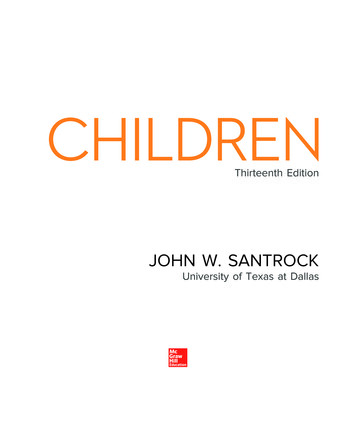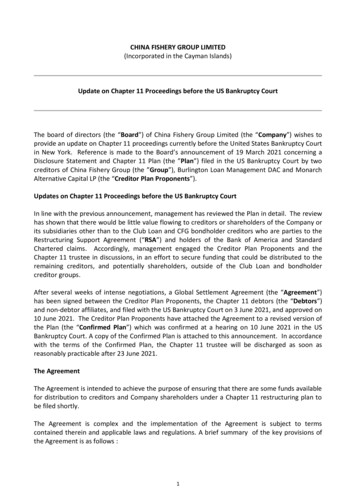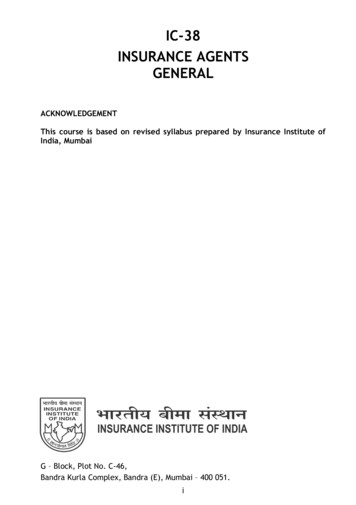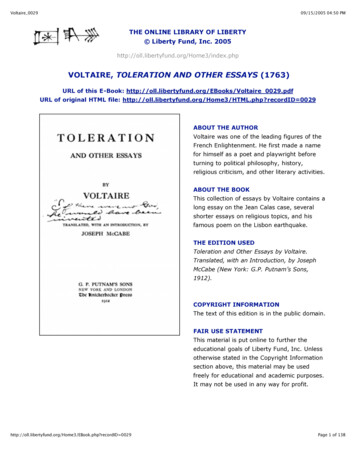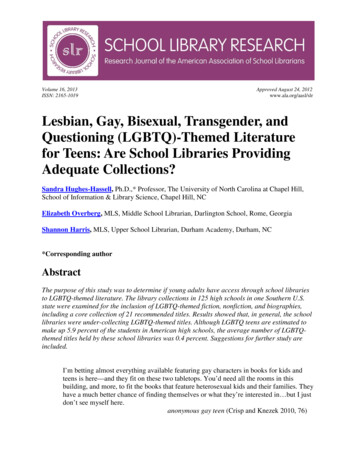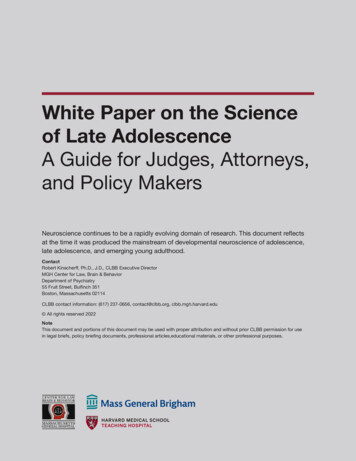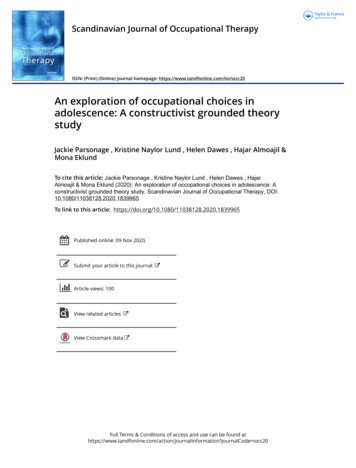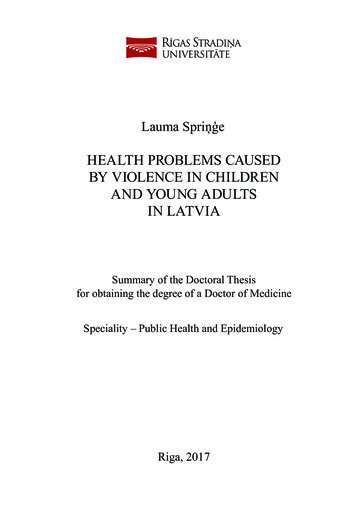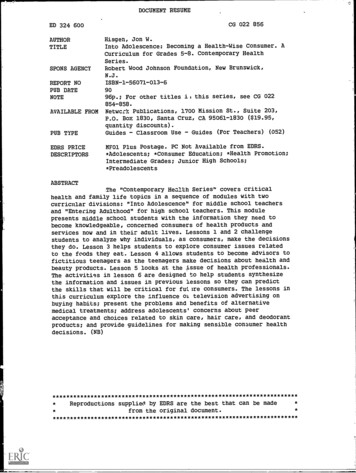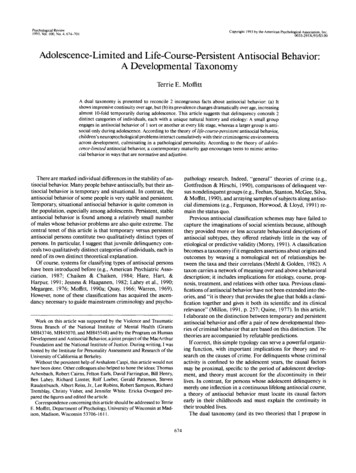
Transcription
Psychological Review1993, Vol. 100, No. 4, 674-701Copyright 1993 by the American Psychological Association Inc0033-295 X/93/S3.00Adolescence-Limited and Life-Course-Persistent Antisocial Behavior:A Developmental TaxonomyTerrie E. MoffittA dual taxonomy is presented to reconcile 2 incongruous facts about antisocial behavior: (a) Itshows impressive continuity over age, but (b) its prevalence changes dramatically over age, increasingalmost 10-fold temporarily during adolescence. This article suggests that delinquency conceals 2distinct categories of individuals, each with a unique natural history and etiology: A small groupengages in antisocial behavior of 1 sort or another at every life stage, whereas a larger group is antisocial only during adolescence. According to the theory of life-course-persistent antisocial behavior,children's neuropsychological problems interact cumulatively with their criminogenic environmentsacross development, culminating in a pathological personality. According to the theory of adolescence-limited antisocial behavior, a contemporary maturity gap encourages teens to mimic antisocial behavior in ways that are normative and adjustive.There are marked individual differences in the stability of antisocial behavior. Many people behave antisocially, but their antisocial behavior is temporary and situational. In contrast, theantisocial behavior of some people is very stable and persistent.Temporary, situational antisocial behavior is quite common inthe population, especially among adolescents. Persistent, stableantisocial behavior is found among a relatively small numberof males whose behavior problems are also quite extreme. Thecentral tenet of this article is that temporary versus persistentantisocial persons constitute two qualitatively distinct types ofpersons. In particular, I suggest that juvenile delinquency conceals two qualitatively distinct categories of individuals, each inneed of its own distinct theoretical explanation.Of course, systems for classifying types of antisocial personshave been introduced before (e.g., American Psychiatric Association, 1987; Chaiken & Chaiken, 1984; Hare, Hart, &Harpur, 1991; Jesness & Haapanen, 1982; Lahey et al., 1990;Megargee, 1976; Moffitt, 1990a; Quay, 1966; Warren, 1969).However, none of these classifications has acquired the ascendancy necessary to guide mainstream criminology and psycho-pathology research. Indeed, "general" theories of crime (e.g.,Gottfredson & Hirschi, 1990), comparisons of delinquent versus nondelinquent groups (e.g., Feehan, Stanton, McGee, Silva,& Moffitt, 1990), and arraying samples of subjects along antisocial dimensions (e.g., Fergusson, Horwood, & Lloyd, 1991) remain the status quo.Previous antisocial classification schemes may have failed tocapture the imaginations of social scientists because, althoughthey provided more or less accurate behavioral descriptions ofantisocial subtypes, they offered relatively little in the way ofetiological or predictive validity (Morey, 1991). A classificationbecomes a taxonomy if it engenders assertions about origins andoutcomes by weaving a nomological net of relationships between the taxa and their correlates (Meehl & Golden, 1982). Ataxon carries a network of meaning over and above a behavioraldescription; it includes implications for etiology, course, prognosis, treatment, and relations with other taxa. Previous classifications of antisocial behavior have not been extended into theories, and "it is theory that provides the glue that holds a classification together and gives it both its scientific and its clinicalrelevance" (Millon, 1991, p. 257; Quine, 1977). In this article,I elaborate on the distinction between temporary and persistentantisocial behavior and offer a pair of new developmental theories of criminal behavior that are based on this distinction. Thetheories are accompanied by refutable predictions.If correct, this simple typology can serve a powerful organizing function, with important implications for theory and research on the causes of crime. For delinquents whose criminalactivity is confined to the adolescent years, the causal factorsmay be proximal, specific to the period of adolescent development, and theory must account for the d/scontinuity in theirlives. In contrast, for persons whose adolescent delinquency ismerely one inflection in a continuous lifelong antisocial course,a theory of antisocial behavior must locate its causal factorsearly in their childhoods and must explain the continuity intheir troubled lives.The dual taxonomy (and its two theories) that I propose inWork on this article was supported by the Violence and TraumaticStress Branch of the National Institute of Mental Health (GrantsMH43746, MH45070, and MH45548) and by the Program on HumanDevelopment and Antisocial Behavior, a joint project of the MacArthurFoundation and the National Institute of Justice. During writing, I washosted by the Institute for Personality Assessment and Research of theUniversity of California at Berkeley.Without the persistent help of Avshalom Caspi, this article would nothave been done. Other colleagues also helped to hone the ideas: ThomasAchenbach, Robert Cairns, Felton Earls, David Farrington, Bill Henry,Ben Lahey, Richard Linster, Rolf Loeber, Gerald Patterson, StevenRaudenbusch, Albert Reiss, Jr., Lee Robins, Robert Sampson, RichardTremblay, Christy Visher, and Jennifer White. Ericka Overgard prepared the figures and edited the article.Correspondence concerning this article should be addressed to TerrieE. Moflfitt, Department of Psychology, University of Wisconsin at Madison, Madison, Wisconsin 53706-1611.674
675TAXONOMY OF ANTISOCIAL BEHAVIORthis article is best introduced with reference to the mysteriousrelationship between age and antisocial behavior. This relationship is at once the most robust and least understood empiricalobservation in the field of criminology.Age and Antisocial BehaviorWhen official rates of crime are plotted against age, the ratesfor both prevalence and incidence of offending appear highestduring adolescence; they peak sharply at about age 17 and dropprecipitously in young adulthood. The majority of criminaloffenders are teenagers; by the early 20s, the number of activeoffenders decreases by over 50%, and by age 28, almost 85% offormer delinquents desist from offending (Blumstein & Cohen,1987; Farrington, 1986). With slight variations, this general relationship between age and crime obtains among males and females, for most types of crimes, during recent historical periodsand in numerous Western nations (Hirschi & Gottfredson,1983). A prototype of the empirical curve of criminal offensesover age is shown in Figure 1.Until recently, research on age and crime has relied on officialdata, primarily arrest and conviction records. As a result, theleft-hand side of the age-crime curve has been censored. Indeed, in many empirical comparisons between early-onset andlate-onset antisocial behavior, early has been artifactually denned as mid-adolescence on the basis of first police arrest orcourt conviction (cf. Farrington, Loeber, Elliott, et al., 1990;Tolan, 1987). However, research on childhood conduct disorderhas now documented that antisocial behavior begins long beforeco5000Q.OQ.4000883000the age when it is first encoded in police data banks. Indeed, itis now known that the steep decline in antisocial behavior between ages 17 and 30 is mirrored by a steep incline in antisocialbehavior between ages 7 and 17 (Loeber, Stouthamer-Loeber,Van Kammen, & Farrington, 1989; Wolfgang, Figlio, & Sellin,1972). This extension to the age-crime curve is plotted in Figure 2. Furthermore, we may venture across disciplinary boundaries to add developmental psychologists' reports of childhoodaggression (Pepler & Rubin, 1991) and mental health researchers' reports of conduct disorder (Kazdin, 1987) to criminologists' studies of self-reported delinquency and official crime. Sodoing, it becomes obvious that manifestations of antisocial behavior emerge very early in the life course and remain presentthereafter.With the advent of alternate measurement strategies, mostnotably self-reports of deviant behavior, researchers havelearned that arrest statistics merely reflect the tip of the deviance iceberg (Hood & Sparks, 1970; Klein, 1989). Actual ratesof illegal behavior soar so high during adolescence that participation in delinquency appears to be a normal part of teen life(Elliott, Ageton, Huizinga, Knowles, & Canter, 1983). With theliberty of some artistic license, the curved line plotted in Figure3 may be taken to represent what is currently known about theprevalence of antisocial behaviors over the life course.Although there is widespread agreement about the curve ofcrime over age, there are few convincing explanations for theshape of the curve. Until recently, scholars still disagreed aboutwhether the adolescent peak represented a change in prevalenceor a change in incidence: Does adolescence bring an increment0 o.%0)20001000CO101520253035404550AgeFigure 1. Age-specific arrest rates for United States Federal Bureau of Investigation's (FBI) index offensesin 1980. (Index offenses include homicide, forcible rape, robbery, aggravated assault, burglary, larceny, andauto theft. From "Criminal Career Research: Its Value for Criminology" by A. Blumstein, J. Cohen, andD. P. Farrington, 1988, Criminology, 26, p. 11. Copyright 1988 by the American Society of Criminology.Adapted by permission.)
676TERRIE E. MOFFITTa.oO.OOo acr"50112 3 4 5 6 7 8 9 10 11 12 13 14 15 16 17 18 19 20AgeFigure 2. The rate of new male offenders at each age per 1,000 male population. (Onset of offending wasdenned as the age at which a child was first taken into custody and designated delinquent by the police.Rates are based on a cohort of 9,945 boys born in 1945 in Philadelphia, Pennsylvania. From DelinquencyIn a Birth Cohort (p. 132) by M. E. Wolfgang, R. M. Figlio, and T. Sellin, 1972, Chicago: The University ofChicago Press. Copyright 1972 by The University of Chicago. Adapted by permission.)in the number of people who are willing to offend or does thesmall and constant number of offenders simply generate morecriminal acts while they are adolescent? Empirical evaluationsnow suggest that the former explanation is correct. In his English study of offense rates over age, Farrington (1983) showedthat the adolescent peak reflects a temporary increase in thenumber of people involved in antisocial behavior, not a temporary acceleration in the offense rates of individuals. This findinghas been replicated in American samples (Wolfgang,Thornberry, & Figlio, 1987). The small human figures underthe curve of Figure 3 portray these changes in prevalence.But whence the increase in the prevalence of offenders? Onepossibility is that some phenomenon unique to adolescent development causes throngs of new adolescent offenders to temporarily join the few stable antisocial individuals in their delinquent ways. Figure 3 depicts the typological thesis to be arguedhere. A small group of persons is shown engaging in antisocialbehavior of one sort or another at every stage of life. I have labeled these persons life-course-persistent to reflect the continuous course of their antisocial behavior. A larger group of personsfills out the age-crime curve with crime careers of shorter duration. I have labeled these persons adolescence-limited to reflecttheir more temporary involvement in antisocial behavior. Thus,timing and duration of the course of antisocial involvement arethe defining features in the natural histories of the two proposedtypes of offenders.Two oft-cited rules of thumb asserted by Robins (1978) seemto simultaneously assert and deny the life-course stability of antisocial behavior: "Adult antisocial behaviour virtually requireschildhood antisocial behaviour [yet] most antisocial youths donot become antisocial adults" (p. 611). In fact, research hasshown that'antisocial behavior is remarkably stable across timeand circumstance for some persons but decidedly unstable formost other people.The stability of antisocial behavior is closely linked to its extremity. The extreme frequency of crime committed by a veryfew males is impressive; it has been repeatedly shown that themost persistent 5% or 6% of offenders are responsible for about50% of known crimes (see Farrington, Ohlin, & Wilson, 1986,for a review). In their study of 10,000 men, Wolfgang et al.(1972) found that 6% of offenders accounted for more than halfof the crimes committed by the sample; relative to otheroffenders, these high-rate offenders began their criminal careersearlier and continued them for more years. The relationship between stability and extremity is found in samples of children aswell. In his analysis of a sample of third-grade boys, Patterson(1982) found that the most aggressive 5% of the boys constitutedthe most persistent group as well; 39% of them ranked above the95th percentile on aggression 10 years later, and 100% of themwere still above the median. Similarly, Loeber (1982) has reviewed research showing that stability of youngsters' antisocialbehavior across time is linked with stability across situations
677TAXONOMY OF ANTISOCIAL BEHAVIOR100%o90%X80%LUCO70%OO60% 50%UOLU40%OLUADOLESCENCELIMITED30%LUrr gure 3. Hypothetical illustration of the changing prevalence of participation in antisocial behavioracross the life course. (The solid line represents the known curve of crime over age. The arrows representthe duration of participation in antisocial behavior by individuals.)and that both forms of stability are characteristic of a relativelysmall group of persons with extremely antisocial behavior.Thus, in defiance of regression to the mean, a group of extremely antisocial persons remain extreme on measures takenat later ages and in different situations. Among other persons,however, temporary and situational manifestations of antisocialbehavior (even to severe levels) may be quite common.This point is vividly illustrated in a longitudinal investigationof a representative cohort of 1,037 New Zealand children bornin 1972-1973. In this sample, I compared the base rates of persistent and temporary antisocial behavior problems (Moffitt,1991). I identified a group of boys whose antisocial behaviorwas rated above average at each of seven biennial assessments(ages 3, 5, 7, 9, I I , 13, and 15). The boys were also rated as veryantisocial by three different reporting agents (parents, teachers,and self). Five percent of the boys in the sample met these selection criteria. As a group, their mean antisocial ratings weremore than a standard deviation above the norm for boys at every age. In contrast, fully two thirds of the remaining boys wererated above average on antisocial checklists as well but at onlyone or two ages or by only one reporter, illustrating that stabilitycannot be inferred from cross-sectional measures of extremity(Henry, Moffitt, Robins, Earls, & Silva, 1993). A disproportion-ate amount of the measured stability in the New Zealand sample could be attributed to the 5% of boys whose antisocial behavior was both extreme and consistent. For example, whenthese few boys were excluded from calculations, the 8-year stability coefficient for teacher ratings was reduced from .28 (R2 .078) to .16 (R2 .025), indicating that 5% of the sampleaccounted for 68% of the sample's stability. (If antisocial behavior had been a stable characteristic throughout the sample, withmost boys retaining their relative standing in the group acrosstime, then excluding the top 5% of the sample should not haveaffected the stability coefficient.) In summary, there appear tobe noteworthy individual differences in the stability of antisocial behavior.I have already alluded to the small number of persons in thegeneral population whose antisocial behavior is life-course-persistent. In fact, epidemiological research has shown that there isremarkable uniformity in the prevalence rates of different manifestations of severe antisocial behavior: Regardless of their age,under 10% of males warrant an "official" antisocial designation.For example, about 5% of preschool boys are considered bytheir parents or caretakers to be "very difficult to manage"(McGee, Partridge, Williams, & Silva, 1991). The prevalence ofconduct disorder among elementary-school-aged boys has been
678TERRIE E. MOFFITTfound to be between 4% and 9% in several countries (Costello,1989; Rutter, Tizard, & Whitmore, 1970). About 6% of boysare first arrested by police as preteens (Moffitt & Silva, 1988c;Wolfgang et al., 1972); such early arrest is important because itis the best predictor of long-term recidivistic offending. The rateof conviction for a violent offense in young adult males is between 3% and 6% (Moffitt, Mednick, & Gabrielli, 1989), andabout 4% of male adolescents self-report sustained careers ofserious violence (three or more violent offenses per year for 5years; Elliott, Huizinga, & Morse, 1986). Finally, the prevalenceof men with antisocial personality disorder is estimated at about4% to 5% (Davison & Neale, 1990; Robins, 1985).It is possible, of course, that the persons who constitute theseepidemiological statistics at different ages are all different individuals. However, the longitudinal data suggest otherwise: It ismore likely that the remarkable constancy of prevalence ratesreflects the reoccurrence of the same life-course-persistent individuals in different antisocial categories at different ages. Robins (1966, 1978) has shown that there are virtually no subjectswith adult antisocial personality disorder who did not also haveconduct disorder as children. White, Moffitt, Earls, Robins, andSilva (1990) found notable continuity from disobedient and aggressive behavior at age 3 to later childhood conduct disorderand thence to arrest by police in the early teen years. Loeber(1982) reviewed research that pinpoints a first arrest betweenages 7 and 11 as particularly important for predicting long-termadult offending. Hare and McPherson (1984) have reported thata conviction for violence in the early 20s is characteristic of almost all men who become diagnosed with antisocial (psychopathic) personality disorder.There are still gaps in the epidemiological database; each ofthe earlier cited studies connected only two or three points inthe life course. Nonetheless, the consistency is impressive: Asubstantial body of longitudinal research consistently points toa very small group of males who display high rates of antisocialbehavior across time and in diverse situations. The professionalnomenclature may change, but the faces remain the same asthey drift through successive systems aimed at curbing their deviance: schools, juvenile-justice programs, psychiatric treatment centers, and prisons. The topography of their behaviormay change with changing opportunities, but the underlyingdisposition persists throughout the life course.Whereas a few males evidence antisocial behavior thatemerges in toddlerhood and is persistent thereafter, the majorityof boys who become antisocial first do so during adolescence(Elliott, Knowles, & Canter, 1981). This tidal wave of adolescentonset has been studied in the aforementioned representativesample of New Zealand boys (Moffitt, 1991). Between ages 11and 15, about one third of the sample joined the delinquent lifestyles of the 5% of boys who had shown stable and pervasiveantisocial behavior since preschool. As a group, these adolescent newcomers to antisocial ways had not formerly exceededthe normative levels of antisocial behavior for boys at ages 3, 5,7, 9, or 11. Despite their lack of prior experience, by age 15, thenewcomers equaled their preschool-onset antisocial peers in thevariety of laws they had broken, the frequency with which theybroke them, and the number of times they appeared in juvenilecourt (Moffitt, 1991). On the basis of such commonly used in-dexes of adolescent delinquency, the two delinquent groupswere indistinguishable. Thus, if the sample was viewed only asan adolescent cross section, researchers would lose sight of thetwo delinquent groups' very different developmental histories,seeing only delinquents and nondelinquents.Indeed, researchers and practitioners cannot yet effectivelyassign individual delinquent adolescents to meaningful subtypes on the basis of cross-sectional "snapshots" of their antisocial behavior during adolescence (Loeber & LeBlanc, 1990;Moffitt, 1990a). Again, the New Zealand sample provides anexample: At age 15, both the childhood-persistent and adolescent-onset groups had members who scored more than 5 standard deviations above the mean on self-report delinquency, andby age 19 both groups had some members with more than 50convictions for crimes in the New Zealand courts. Elliott andHuizinga (1984) reported similarly poor classification in a representative sample of American teens. They attempted to discriminate, at the time of first arrest, individual future careeroffenders from adolescence-limited offenders. Discriminationcould not be improved beyond chance by entering the kindsof information typically available to officials: type of currentoffense, age, sex, race, class, involvement with delinquent peers,and attitudes toward deviance. Addition of measures of the extremity of self-reported delinquency and emotional problemsimproved prediction only 7% beyond chance. Earlier, I notedthat the stability of antisocial behavior implies its extremity butthat extremity does not imply stability; measures of the frequency or seriousness of adolescent offending will not discriminate very well between life-course-persistent and adolescencelimited delinquents. On the basis of their study and others, Elliott and Huizinga concluded that there is "no effective meansfor discriminating between the serious career offenders andnonserious offenders" (p. 98). A notable feature of the taxonomy introduced in this article is that knowledge of a subject'spreadolescent behavior is required for making the differentialdiagnosis between the life-course-persistent and adolescencelimited types of antisocial teenager. Longitudinal designs areneeded to collect the lifetime repeated measures that are neededto distinguish individual differences in the developmentalcourse of antisocial behavior.1I have argued in this section that juvenile delinquency conceals two categories of people. A very large group participates inantisocial behavior during adolescence. A much smaller group,1It may be countered that research has distinguished delinquent subtypes that are based on cross-sectional information. For example, thedelinquent behaviors of the life-course-persistent type may be distinguished by relatively more overt aggression, whereas the adolescencelimited type may show relatively more covert offending under peer influence. I agree. Factor-analytic studies have revealed an aggressive "undersocialized" factor and a "socialized" peer-oriented factor (Quay,1964a, 1964b, 1966), and meta-analytic studies have revealed "overt"and "covert" offense patterns (Loeber & Schmaling, 1985). However,such scale pairs are highly and positively correlated in adolescent samples, in which the evidence for offense versatility outweighs evidencefor offense specialization (Klein, 1984; Robins, 1978). Cross-sectionalclassification has not proven effective at the level of the individual. Myassertion that developmental history is needed for confident classification is buttressed by the repeated finding that age of onset of antisocial
TAXONOMY OF ANTISOCIAL BEHAVIORwho continues serious antisocial behavior throughout adulthood, is the same group whose antisocial behavior was stableacross the years from early childhood. The categories remainhypothetical types, because no longitudinal study has yet repeatedly measured antisocial behavior in a representative sample of the same individuals from preschool to midlife. I describein the next sections the two hypothetical types of antisocialyouth: life-course-persistent and adolescence-limited. I arguethat the two groups differ in etiology, developmental course,prognosis, and, importantly, classification of their behavior aseither pathological or normative. The goal of this article is toproffer a description of the two types in the form of a set oftestable predictions.Life-Course-Persistent Antisocial BehaviorMy account of the life-course-persistent antisocial type follows this plan: In the first section, Continuity of Antisocial Behavior Defined, I provide a definition and description of persistent antisocial behavior. In the second section, Beginnings: Neuropsychological Risk for Difficult Temperament and BehavioralProblems, I present the hypothesis that persistent antisocial behavior has its origins in an interaction between children's neuropsychological vulnerabilities and criminogenic environments. In the third section, Maintenance and Elaboration Overthe Life Course: Cumulative Continuity, Contemporary Continuity, and Narrowing Options for Change, I introduce the cumulative and contemporary processes that maintain antisocialbehavior across time and that expand antisocial behavior into apervasive adult life-style. In the fourth section, I summarize thetheory's perspective on continuity, and in the fifth section, Imake a case that life-course-persistent antisocial behavior is aform of psychopathology.Continuity of Antisocial Behavior DefinedAs implied by the label, continuity is the hallmark of thesmall group of life-course-persistent antisocial persons. Acrossthe life course, these individuals exhibit changing manifestations of antisocial behavior: biting and hitting at age 4, shoplifting and truancy at age 10, selling drugs and stealing cars at age16, robbery and rape at age 22, and fraud and child abuse at age30; the underlying disposition remains the same, but its expression changes form as new social opportunities arise at differentpoints in development. This pattern of continuity across age ismatched also by cross-situational consistency: Life-course-persistent antisocial persons lie at home, steal from shops, cheat atschool, fight in bars, and embezzle at work (Farrington, 1991;Loeber, 1982; Loeber & Baicker-McKee, 1989; Robins, 1966,1978; White etal., 1990).The concept of behavioral coherence, or heterotypic continuity, is invoked here to extend observations of continuity beyondthe mere persistence of a single behavior to encompass a varietyof antisocial expressions that emerge as development affordsbehavior problems is the single best predictor of adult criminal outcomes (Farrington, Loeber, Elliott, etal., 1990).679new opportunities. Heterotypic continuity refers to continuityof an inferred trait or attribute that is presumed to underliediverse phenotypic behaviors (Kagan, 1969). As Kagan andMoss (1962) suggested, a specific behavior in childhood mightnot be predictive of phenotypically similar behavior later inadulthood, but it may still be associated with behaviors that areconceptually consistent with the earlier behavior.Examples of heterotypic continuities have been reported byRyder (1967), who found that childhood aggression, physicaladventurousness, and nonconformity were related to adult sexual behavior. Another example of coherence is provided in a 22year follow-up study of men and women who had been rated asaggressive by their peers in late childhood (Huesmann, Eron,Lefkowitz, & Walder, 1984). As adults, the men were likely tocommit serious criminal acts, abuse their spouses, and drivewhile intoxicated, whereas the women were likely to punishtheir offspring severely. Another example of personality coherence is the finding that the developmental antecedents of erraticwork histories may be found in phenotypically dissimilar attributes of difficult temperament in childhood (Caspi, Elder, &Bern, 1987). In addition, in their hallmark study, West and Farrington (1977) observed that stealing, alcohol abuse, sexualpromiscuity, reckless driving, and violence were linked acrossthe life course. The prognosis for the life-course-persistent person is bleak: Drug and alcohol addiction; unsatisfactory employment; unpaid debts; homelessness; drunk driving; violentassault; multiple and unstable relationships; spouse battery;abandoned, neglected, or abused children; and psychiatric illness have all been reported at very high rates for offenders whopersist past the age of 25 (Farrington & West, 1990; Robins,1966; Sampson & Laub, 1990). Thus, this theory of life-coursepersistent antisocial behavior predicts continuity across the entire life course but allows that the underlying disposition willchange its manifestation when age and social circumstances alter opportunities.Although reports of the continuity of antisocial styles fromchildhood to young adulthood abound, the outcomes of antisocial individuals during midlife have seldom been examined.The pattern of official crime over age (Figure 1) implies thatcriminal offending all but disappears by midlife,2 but there isno reason to expect that life-course-persistents miraculously assume prosocial tendencies after an antisocial tenure of severaldecades. Indeed, criminal psychopaths decrease their numberof arrestable offenses at about age 40, but the constellation ofantisocial personality traits described by Cleckley (1976) per2The conclusion that crime ceases in midlife may be premature; it isbased on cross-sectional age comparisons of arrest and conviction rates.There are at least four reasons to doubt the conclusions that have beenbased on this method. First, official records underestimate the amountof true crime. Second, there may be justice-system biases toward underarrest and prosecution of older persons. Third, death and imprisonmentmay selectively remove persistent offenders from official crime statistics.Fourth, cross-cohort compa
crime over age, there are few convincing explanations for the shape of the curve. Until recently, scholars still disagreed about whether the adolescent peak represented a change in prevalence or a change in incidence: Does adolescence bring an increment c o Q. O Q. 8 8 5000 4000 3000 0o . % 2000 0) 1000 CO 10 15 20 25 30 35 40 45 50 Age Figure 1.

